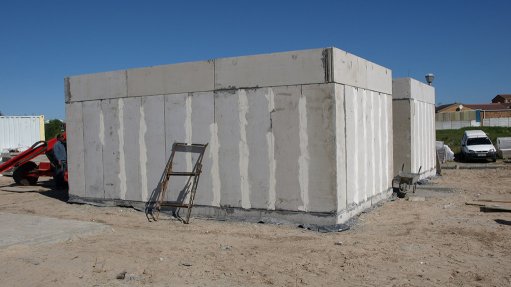
WALLED OFF Lepa’s lightweight construction panels are designed to keep rooms cool in summer and warm in winter
Operational campsite design specialist Akhani Group signed an agree-ment with alternative housing solutions provider Lightweight Energy Panels Africa (Lepa) in June to market and distribute Lepa’s lightweight construction panels.
The panels are used to build temporary and permanent living structures at mine sites in South Africa.
Lepa’s solutions incorporate tongue-and-groove energy panels and mortar sizing liquid to bind and seal.
“This construction method is 300% faster than the conven-tional style, which results in a 75% reduction in labour costs. In addition, the simplicity of the system allows for the employ-ment of unskilled labour,” says Akhani Group COO Deon Fuhri, adding that Lepa’s product is suitable for use in alternative housing structures, as it is designed to keep rooms cool in summer and warm in winter.
“It is also easy to erect and maintain,” he explains.
Fuhri tells Mining Weekly that since signing the agreement with Lepa, the product has been presented to some of the company’s clients, including platinum mining major Lonmin, ferrous metals miner Assmang, and Tanzania’s national real estate development and management firm National Housing Corporation.
“This is a big step for our group, as this product will complement our exhaustive list of products to service the remote site housing market.
“We can now build a 70 m3 two-bedroom house in 14 days for under $410/m3. “We are also proud to announce that this product carries the approval of the South African government through the National Home Builders Registration Council and Agrément South Africa,” says Fuhri.
Agrément South Africa, which has an agreement with the Department of Public Works and the Council for Scientific and Industrial Research, aims to certify nonstandard material in the built environment.
Fuhri highlights that, in 2013, then Human Settlements Minister Tokyo Sexwale endorsed Akhani’s products after the company built a double-storey show house in Cape Town as part of govern-ment’s Legacy Project.
This project is an initiative that aims to establish com-memorative symbols of South Africa’s history to celebrate its heritage. These symbols include monuments, museums, plaques, outdoor art and heritage trails.
Features and Benefits
Tests conducted at the Inter-national Standards Organisation (ISO) and Agrément South Africa determined that Lepa’s technology was four times stronger and more durable than a conventional brick and mortar structure, says Fuhri.
Further, ISO testing revealed that the lightweight construc-tion panels remained incom-bustible and nontoxic and did not emit any poisonous gases when exposed to 1 000 °C for four hours.
Lepa’s lightweight panels do not contain any wood or steel and have been treated with anti-freeze additives to prevent the formation of mould.
“At a conventional building site, a wastage of 25% in heat energy is evident, compared with our product, which displays less than a 1% wastage. Tests also showed that Lepa’s technology achieved 96% energy retention,” says Fuhri.
Further, the insulation that Lepa uses to retain energy simul-taneously results in a superior sound insulation of 43 dB, com-pared with a conventional house that has sound insulation of 32.8 dB.